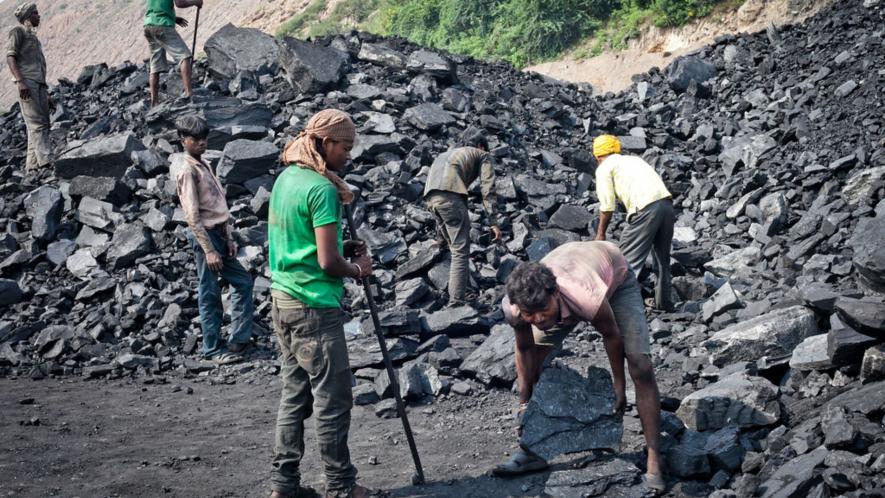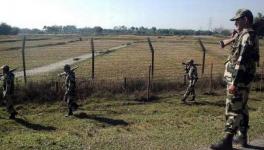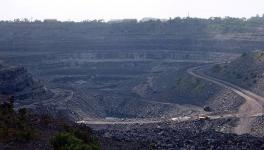Rat Hole Mining: Tragic Accident Exposes Dark Side of Nagaland’s Coal Sector

Representational Image. Image Courtesy: Flickr
New Delhi: Rat-hole coal mining is widespread in the northeastern state of Nagaland, as brought to the limelight by a tragic accident recently, even though this dangerous practice was declared illegal in neighbouring Meghalaya a decade ago. At least six migrant labourers were killed in an explosion in a rat-hole mine in Nagaland’s Wokha district on January 25, in Ruchyan village near the state’s border with Assam.
As per officials, the mine where the accident took place was “illegal” even though rat-hole mining is permissible in Nagaland.
“The ill-fated mine in Wokha district was illegal because it did not have the mandatory clearances from the government. Rat hole mining is permissible in Nagaland, but it must be undertaken only with consent from the concerned departments,” Principal Secretary of Nagaland’s Geology & Mining Department, Himato Zhimomi, told this correspondent.
Nagaland has 492.68 million tons of coal reserves. However, these deposits are dispersed erratically and inconsistently in small pockets spread over large areas across the state. The deposits do not have sufficient coal reserves that can be extracted through large-scale operations for “scientific, economic development in a coordinated and integrated manner”. The state’s coal policy, which was first notified in 2006, therefore allows for “rat hole mining” over these deposits through private individuals by awarding leases that are called Small Pocket Deposit Licenses.
“Small Pocket Deposit License may be granted only to individual landowners for undertaking rat-hole mining and shall not be granted to any company. The license period shall not exceed 1 (one) year, where the intended mining area does not exceed 2 (two) hectares, and annual coal production does not exceed 1,000 tons per annum and heavy machinery is not used for extraction,” says the Nagaland Coal Policy (First Amendment) 2014 (See Section 6.4 (ii)).
Zhimomi further said that the Nagaland government awarded several rat hole mining leases, with proper clearances pertaining to forest and environment and definite mining plans. But instances of illegal rat hole mining, which do not have clearances, have also been unearthed in the past by the police and the administration.
In March 2019, at least four workers were killed, reportedly in a mudslide accident, at an abandoned coal mine in Nagaland’s Longleng district. The deceased were identified as migrant workers from Assam. In yet another accident reported from the Mokokchung district in March 2021, another four migrant workers from Assam were killed by a suspected poisonous gas leak from an illegal mine in which they were working.
The state’s coal policy document itself takes cognisance of the extent of illegal coal mining that private individuals and landowners carry out in Nagaland. These activities are rampant in the Wokha, Mokokchung, Dimapur, Mon, Longleng and Peren districts. The document states:
“These rampant and illegal mining activities have resulted in various types of accidents, health hazards, ecological and environmental degradation; besides loss of coal resource and leakages through process exits have caused substantial state revenue loss.”
Due to the unique land-holding system in Nagaland, under Article 371 of the Constitution of India, land and natural resources belong exclusively to the state’s citizens. Traditionally, all coal mining activities in Nagaland have been carried out by individuals and communities, with the state's role in awarding leases remaining confined to the collection of royalties alone.
Further, the Nagaland Coal Policy (First Amendment) 2014 and the Nagaland Coal Mining Rules, 2006 – both formulated as per the Mines and Minerals (Development and Regulation) Act, 1957 – envisage upon the state government to share 10 per cent of the royalties to the local village councils through a system known as “Naga Commission”. The Nagaland Coal Mining Rules, 2006 also contains several instructions for the state government, including the duty to issue guidelines for precautions against toxic gas generated from operational mines as well as against fires and spontaneous heating. These measures seem to have been overlooked by the state government, resulting in mine-related accidents in the past.
In an assessment conducted in the past, the Nagaland government’s Directorate of Geology and Mines found that coal extracted by private miners in the state is “sold to nearby brick kilns and tea gardens at very cheap rates”.
As per an audit report finalised in May 2023 by the Government Accounting Standards Advisory Board (GASAB), a nodal accounting body under the Comptroller and Auditor General (CAG) of India, six coal prospecting licenses and 11 coal mining licenses awarded by the Nagaland government, are active at present in the state. The report, Natural Resource Accounts of Nagaland for the Year 2020-21, was scathing in its attack upon the state’s Directorate of Geology and Mines for its failure to curb illegal mining and its revenue losses.
During 2020-21, the Nagaland government collected a meagre royalty of Rs 2.19 crore from coal mining at a rate of Rs 420 per ton, up from a measlier sum of Rs 0.72 crore collected a year earlier. The GASAB audit found that the department did not have details of the production and sale of coal for any of the years in the past. There was no mechanism in place to weigh the amount of coal extracted in the state apart from counting the number of trucks used for transportation, even though the royalty amount is always collected in advance from the licensees. No data was found with the directorate pertaining to establishing check gates to thwart illegal transportation of coal.
“Erection of Mineral Check gates and mobile check gates for detection and collection of Royalties from illegal transporters was envisaged in the Nagaland Coal Policy 2014 with a penalty of 50% of royalty rate per ton over and above the actual rate of royalty at the spot shall be imposed but no data is found on the erection of such Check Gates. Similarly, setting up of Coal Depots and installation of Weigh Bridges within the zone of extraction of coal and boundaries of Nagaland to conduct trade and export of coal is required, but no data is available with the Department of Geology & Mining regarding setting up of Coal Depots and Weigh Bridge. Resultantly, the department could not monitor illegal mining effectively,” said the audit report.
The audit also noted the absence of a cross-verification mechanism between different government departments to curb illegal mining. “Even though both Geology & Mining and Forest Departments have departmental check gates/weighbridge points, no data is available for cross-verification. Since no mechanism exists for measuring actual extraction of coal/minerals by Departmental agencies other than Village Councils, chances of illegal mining of mineral/coal and transportation/exporting from the State of the same cannot be ruled out,” it further stated. The audit report also arrived at the surprising conclusion that there were no District Mineral Foundations – funds collected by taxes from mining to benefit communities affected by mining – in the entire Nagaland.
In Nagaland’s neighbouring state of Meghalaya, India’s premier environmental court, the National Green Tribunal (NGT), banned rat-hole mining in November 2014 on the grounds that it was a dangerous practice and could result in human fatalities. Nevertheless, the scourge of illegal coal mining has continued in Meghalaya through a powerful lobby of contractors, miners, and transporters, notwithstanding even the stern warnings issued upon the state government by various courts of the country from time to time.
Activists allege that a similar lobby in Nagaland has also stymied all efforts to end the practice of rat-hole coal mining. This lobby, allegedly, has also spawned a massive inter-state human trafficking network with possible links to the neighbouring country of Myanmar, which shares a porous border with Nagaland. A Free Movement Regime (FMR), implemented by the central government in 2018 as part of its Look East Policy, allows people close to the India-Myanmar border to venture up to 16 km into each other’s territories without a visa. It has been alleged by experts in the security establishment that the FMR is not only being used to push insurgents but also migrant workers from Myanmar into the northeastern states of India.
All labourers killed in the three mining-related accidents in the recent past in Nagaland reportedly belonged to poverty-stricken communities of various districts in Assam.
“These workers seemed to have been trafficked. In Meghalaya, too, workers trafficked by contractors from various poverty-stricken areas are regularly employed in the dangerous illegal rat-hole mines. The trafficking always takes place in a surreptitious manner, away from the prying eyes of the police and administration. It is difficult to identify trafficked workers from amongst civilians,” said Shillong-based activist Agnes Kharshiing.
In a botched-up counter-insurgency operation on December 4, 2021, soldiers of the Indian Army’s 21 Para Special Force shot dead as many as six civilians, suspecting them to be militants. It later emerged that the pick-up van, upon which the soldiers opened fire, was carrying coal mine workers from Tiru to Oting village in the Mon district of Nagaland. A crowd of protestors who set fire to Army vehicles were fired upon again by the soldiers, resulting in the death of seven more civilians. A day later, yet another civilian was killed when security forces opened fire upon protestors who had breached a camp of the Assam Rifles.
“The laxity of the police and labour departments has resulted in trafficking of workers. Only a thorough investigation will reveal if these powerful syndicates are linked to high-ranking government officials and politicians in the northeastern states,” added Kharshiing.
The writer is a freelance journalist.
Get the latest reports & analysis with people's perspective on Protests, movements & deep analytical videos, discussions of the current affairs in your Telegram app. Subscribe to NewsClick's Telegram channel & get Real-Time updates on stories, as they get published on our website.
























